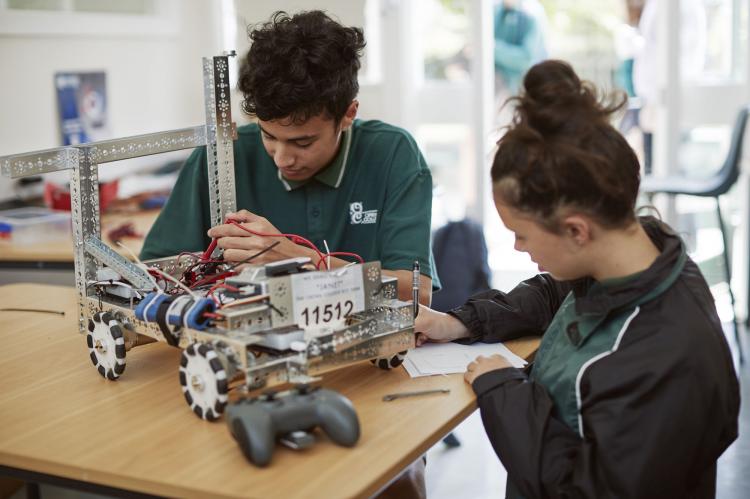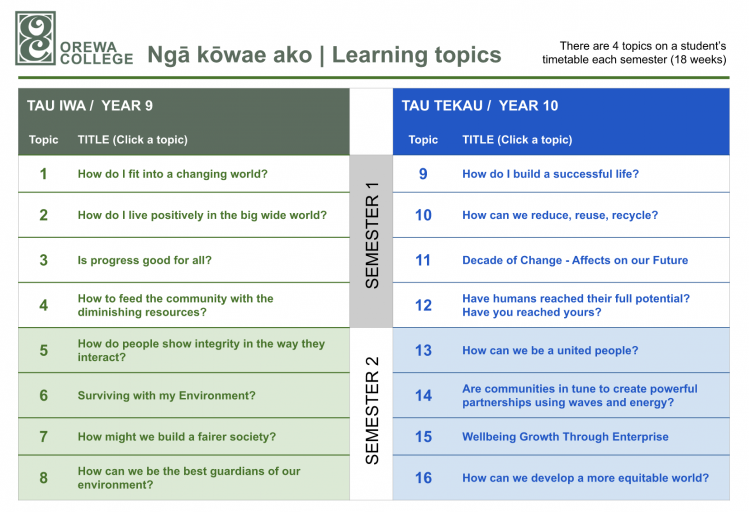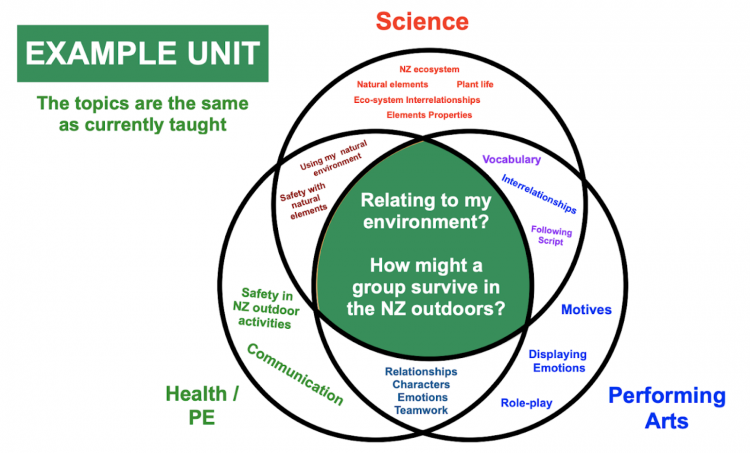Year 9 and 10 Integrated programme at Orewa College
Tags: Cross-curricular | Lower secondary | Secondary |
In January 2020 Orewa College trialled an integrated curriculum approach. Year 9 and 10 students no longer had timetabled specialist subjects. Instead, they designed a local curriculum in which students undertook eight topics during the year with each topic being taught by three specialist teachers. This snapshot outlines why the school took this route, how the approach was developed and the learnings from the evaluation after six months.
Curriculum review
In 2018 the school launched a curriculum review to consider new approaches to better align the National curriculum with its own contemporary thinking about effective learning and how to prepare students for the world they live in today.
Feedback from students was gathered, which highlighted issues and concerns from their perspective and helped inform the design of the programme. Students critical feedback included finding school boring, too hard, or disconnected between different subjects.
We’d had stories that are pretty shocking, kids would rather not come to school. It even goes for the high achievers. I can go to the top year nine class, one extension class, they say, “It’s really boring. Why can’t I stay at home?’”
We’ve found so many embarrassing double ups. One subject says, “Oh, we show that movie too! What, do you mean that year 9’s have watched that movie twice? Yes they have, did they not say anything? No, they were happily killing time.” So Secondary school time is for killing not for learning. We found lots of frightening examples of things like that.
Whatever we do today, the kids would rather not do it. 2000 kids who would rather not come to this experience. Do you want to own that? Do you want to just ignore it and say that that’s just the only way school can be. It’s the law, school has to be this way.
– Richard Wells, Deputy principal, Orewa College
After debate and feedback from the community, the school decided:
- subject area teachers would work together to link topics and objectives in groups of three subjects
- the curriculum would better encourage the values and principles of The New Zealand Curriculum
- the timetable would be simplified to make lesson times longer to allow for more depth
- time would be set aside to further develop each student’s interests and keenness to learn.
Topics not subjects
The review highlighted that activity in the working world involves a bit of everything, rather than discrete specialist subject knowledge and skills. So, the school decided to explore how content from three subjects could be linked together into topics. Each topic was given one of the school’s values as a foundation to build on. The result was the creation of 16 integrated learning topics, each designed by a team of six teachers from across the three learning areas.
When the teams of six came together they’d never met, in most cases…. the silos are so strong that two people who have worked in the school for ten years don’t know each other – they have never met.
Seventy five students are timetabled together to do the same topic in a zone of three rooms with the three specialist teachers for 60 or 90 minutes. At any one time, students’ timetables will consist of four topics, each based on a school value. Each topic lasts one semester so in each year they will engage in eight topics that cover all eight of the school values.
Example unit
A science, health & PE, and performing arts integrated topic is based on outdoor survival in the bush and uses sustainability as its key value. This topic provides the context for the learning. The result is an 18 week unit about four people surviving in the bush. It uses a performance as a way of showing what they’re dealing with and how they would survive as a group.
In this example students might explore:
- science – relationships between living things
- health – leadership and relationships between people
- drama – relationships and displaying emotions.
Students explore the concept of sustainable relationships across each of the subjects. Within an engaging context, they learn to make connections between:
- the key value
- the specialist subject knowledge
- skills or competencies.
The topics are designed to provide students with agency and ownership of what and how they are learning.
Each topic comprises of five main phases:
- Introduction – exploring the topic’s big theme
- Knowledge – learning knowledge and skills
- Integration – making sense of the issues
- Planning – preparing to display learning and/or have an impact
- Create, critique, and reflect
We are not just doing topics for the sake of doing the topic. Now it is in context, for this unit you are going to need to know this. At least we can now say, “there is a need” rather than “today we are doing”. Switching from the word “do” to the word “need” is useful.”
A truly values based curriculum
Values are deeply held beliefs about what is important or desirable. They are expressed through the ways in which people think and act. Every decision relating to curriculum and every interaction that takes place in a school reflects the values of the individuals involved and the collective values of the institution.
The school made sure their values featured firmly in the design of the topics with each topic being centred around a different value.
Orewa College values
Mai time
Students spend four hours each week working alone or as part of a group on activities that are driven by personal interests, passions or needs. The aim is to engage students so they enter a state of flow where time flies and they are engrossed as they work. It doesn’t matter what it is as long as they take it so seriously that time flies.
Flow is being completely involved in an activity for its own sake. The ego falls away. Time flies. Every action, movement, and thought follows inevitably from the previous one, like playing jazz.
Mihaly Csikszentmihalyi
Examples of Mai Time activities include:
- writing club
- online course
- drawing club
- drama club
- radio station
- robotics club
- coding
- TV station
- community impact projects.
Ako time
So we’ve got a small team of people who’ve put together a physical box – every ako group gets a 40 litre box of toys and tools and games. How do I work with other people, how do I meet a stranger, how do I talk with a stranger, how do I critique somebody else’s work?
Richard Wells, Deputy principal Orewa College
Students spend four hours a week Ako time in which a tutor works with students to track their progress and understanding of the curriculum topics and reports to parents and caregivers on academic issues. There is a structured programme for tutors to work with students to build specific skills such as self-management, teamwork and learning to learn. Students keep a record of learning in their Ako log and discuss this regularly with their Ako tutor.
The Ako time is different to the morning Form time which is more for attendance, assemblies and house involvement.
Digital technology as an enabler of learning and collaboration
Google’s GSuite provides a key platform that enables collaboration between students and teachers. It is easily adopted because it works across devices such as iPads, cell phones and laptops running Microsoft Windows or MacOS.
Google Classroom is the main tool used to organise, present, and manage the digital artefacts for each topic.
Evaluation
An evaluation after six months of the integrated approach found:
- students enjoyed looking at bigger-picture issues and referring to values like innovation and diversity, rather than just subject names
- where teachers were working well together, the new integrated approach made much more sense
- the timetable structure needed simplifying
- some students made topic option choices that meant they were timetabled into other topic options they were not keen on
- some teachers were not on-board with the integrated curriculum approach and this had a significant impact
- teachers found working with larger cohorts of students challenging
- the planned integration was not carried out smoothly or consistently by all teachers
- Ako time (learning mentoring) and Mai time (personal project time) needed more support and structure
- some students did very well in Mai time, booking facilities and teachers to help them, while producing technology projects of their own or writing over 20,000 words of their first novel
- some students found having more teachers (due to team teaching) preferable as “you’re not stuck with one teacher all year.”
As a result of the evaluation, the trial was paused for the remainder of the year and the focus became:
- a smaller form of integration
- structured Ako time (learning mentoring) with a form tutor
- Mai time (personal project time) for those students ready to run projects – possibly as an option on the regular timetable.
The experience has shown the need to continue development in:
- inquiry learning
- progress tracking against levels
- team-teaching
- new pedagogies.
More information »
- 2020 A school reborn – blog series by Deputy Principal Richard Wells.
Research
Curriculum integration: What is happening in New Zealand schools?
This research report presents findings on teachers’ rationales for curriculum integration; the approaches and practices used to integrate curriculum; and the learning opportunities these approaches provide for students. Published 2019.




